January 8, 2024
37 Essential Remote Work Tools for 2024
In this article, we’re going to do a deep dive into the best remote working tools on the market in 2024. Fo...
If you’re running a business or managing a team, you need a way to track annual leave, sick leave and other absences. One way to do this, without investing in any expensive software tools, is to set up a Google Sheets PTO tracker.
An employee leave tracker helps you manage the work schedule and avoid delays or issues with short-staffing when team members are on annual leave. It will also help you identify trends related to absenteeism, or staff who don’t take enough leave.
Keep reading and we’ll show you how to set up a simple vacation and sick time tracking spreadsheet in Google Sheets or Excel. We’ll also give you a paid time off tracker template you can start using straight away.
Here’s a simple process to put together a paid time off tracking spreadsheet. We’ll show you how to do it in Google Sheets – but it can work exactly the same in Excel, or your chosen spreadsheet tool.
First, you’ll want to set up a calendar view for your employee annual leave tracker.
The optimal way to do this is one month at a time, generally with each month in its own sheet. Make a column for each day of the month, and color in the weekends, team-wide public holidays and any other non-working days.

Click here to see a full list of this year’s public holidays all over the world.
Fill out your employee names in the left-most column, giving each team member their own separate row.
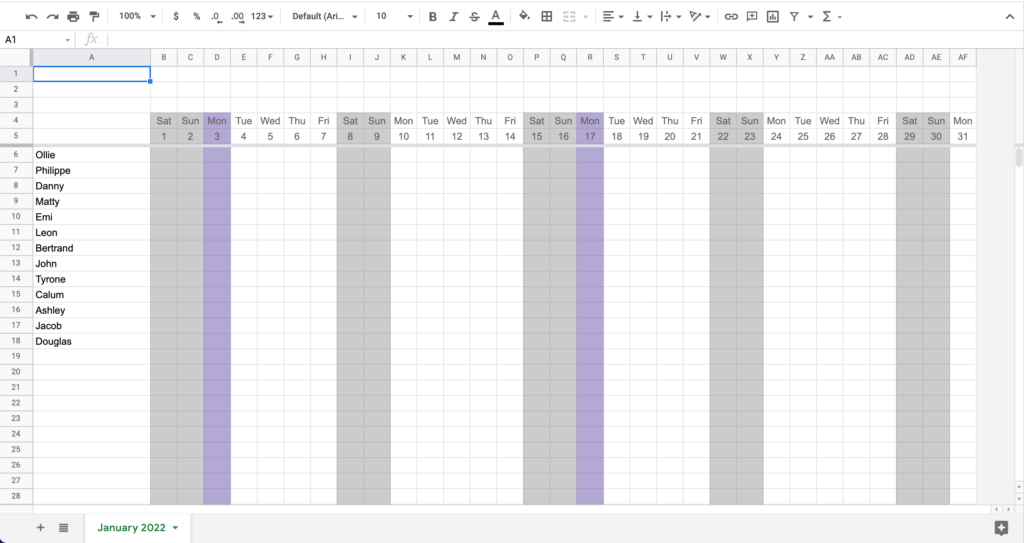
Now create a key to show how each leave type is indicated. You could use letters, symbols, colors or a combination of each.
Here’s an example, using colors:
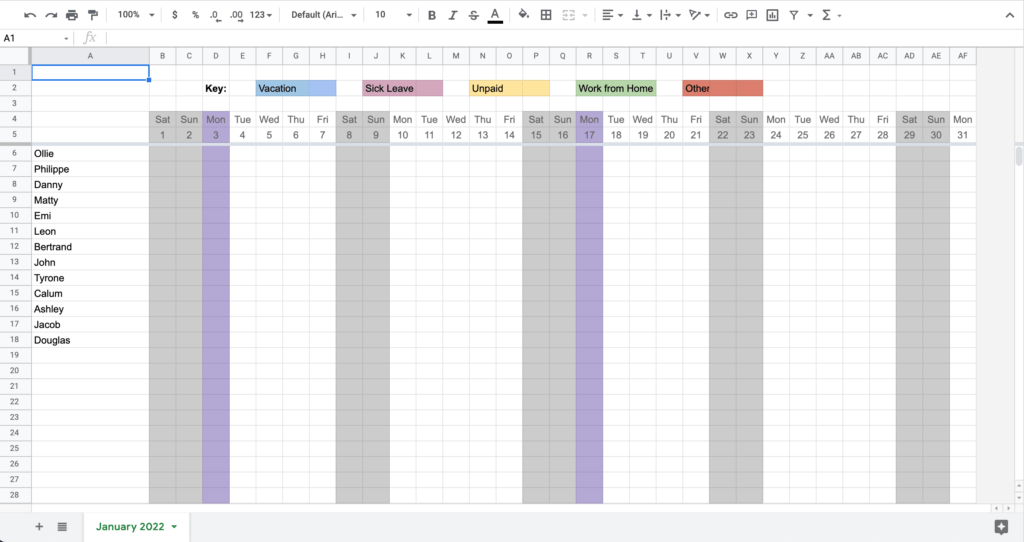
With leave data entered into your PTO tracker it will look something like this:
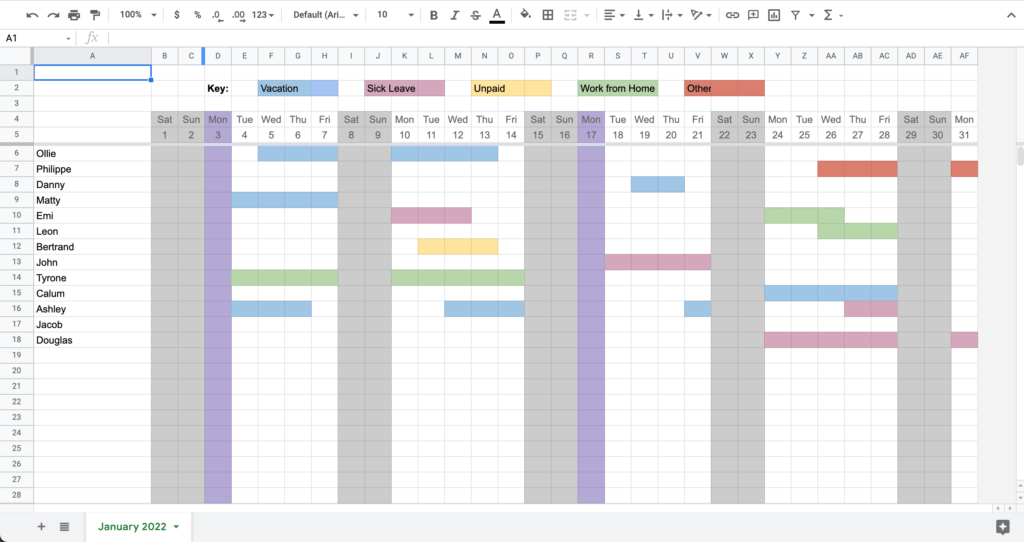
Tip: the color-coded approach is easy to view. But if you want to do something more complex, like adding a “half day” leave type in your employee leave tracker, displaying leave by numbers or symbols will work better.
If you want your vacation and sick time tracking spreadsheet to keep track of the total number of leave days taken each month, add a separate column at the end, and add up the totals at the end of the month.
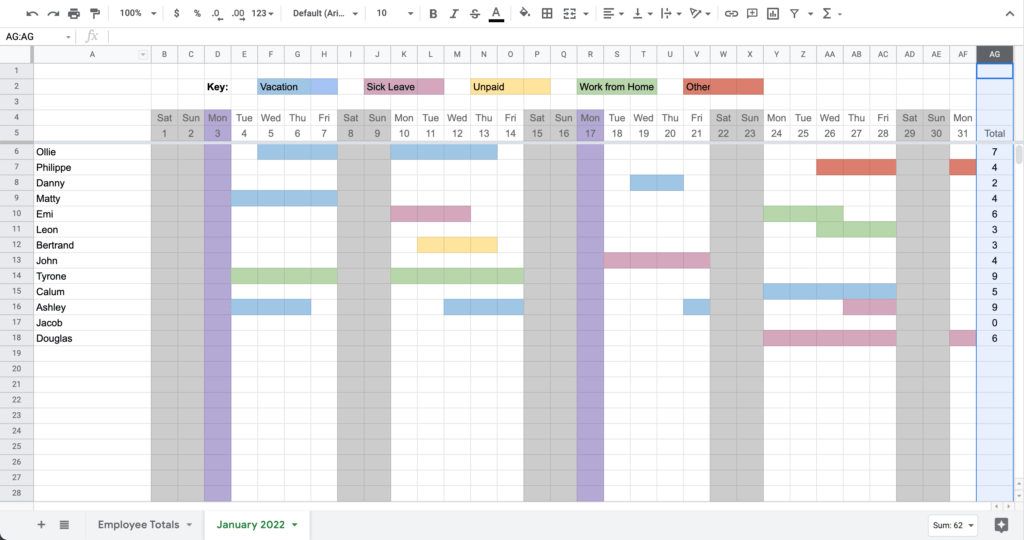
You can also add a separate tab to track each employee’s yearly allocation for each leave type.

If your business runs an unlimited PTO policy, your paid time off tracker doesn’t need to calculate the total number of days/days remaining for each team member. But you’ll still want to track how many days each employee takes off, to identify employees who take an excessively high or low amount of PTO.
Related: Check out some of the most insightful Unlimited PTO Statistics.
As leave requests come in and get approved, fill the necessary data on your leave tracker.
Duplicate the tab we made for the first month, and adjust the days/weekends to fit the next month. Don’t forget to also add in public holidays.
Want to use this Google Sheets PTO tracker in your business?
Hit the button below to access our leave tracker template template, updated for 2024. Just customize it with your employees’ names and your leave types, and save a copy in your own Google Drive to use it in your business for free.
If you use Excel, the template will still work for you. To get the excel file, click File – Download, and choose Microsoft Excel (.xlsx).
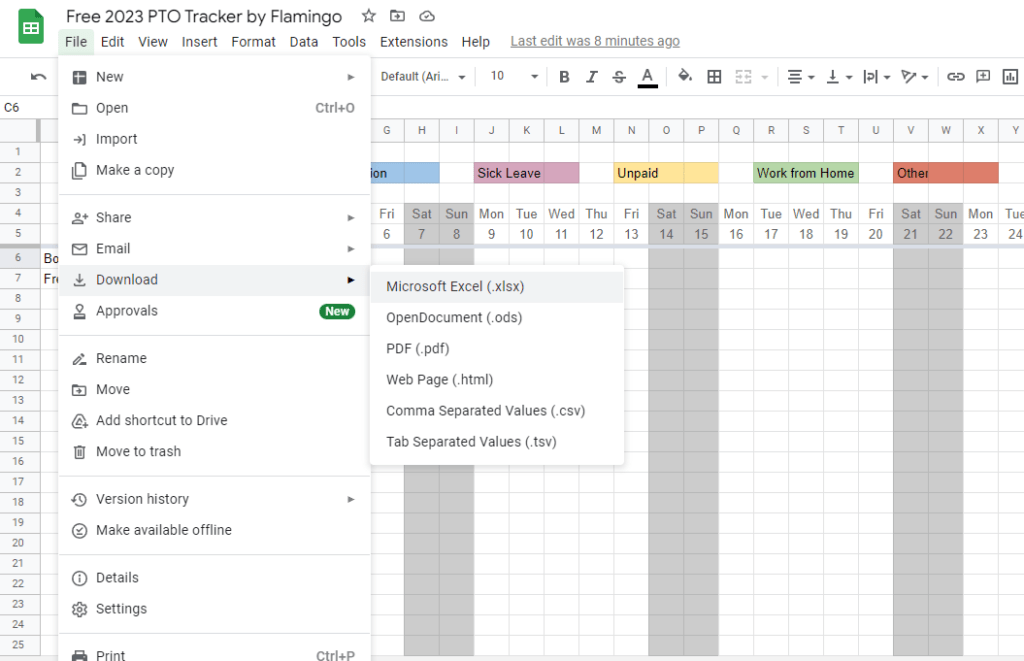
This will give you the leave tracker excel template which you can open and customize for your own use.
Many small businesses use a paid time off tracking spreadsheet because it’s convenient, free, and uses software you’re already familiar with. But is a Google/Excel spreadsheet the best option for tracking time off in your business?
Here are some pros and cons of using an Excel or Google Sheets PTO tracker.
The best part of using Google Sheets is that it’s free and it’s already there. You don’t need to sign up for an expensive subscription or get to know a new tool. This could be a big plus for new startups or growing businesses trying to keep expenses to a minimum.
Google Sheets is cloud-based and viewable across all kinds of platforms. It doesn’t matter whether you’re on Mac or Windows, desktop, mobile or tablet, whether you’re in the office, out at lunch, or on your backup computer. You can still access your company’s PTO tracker to check or update it when you need to.
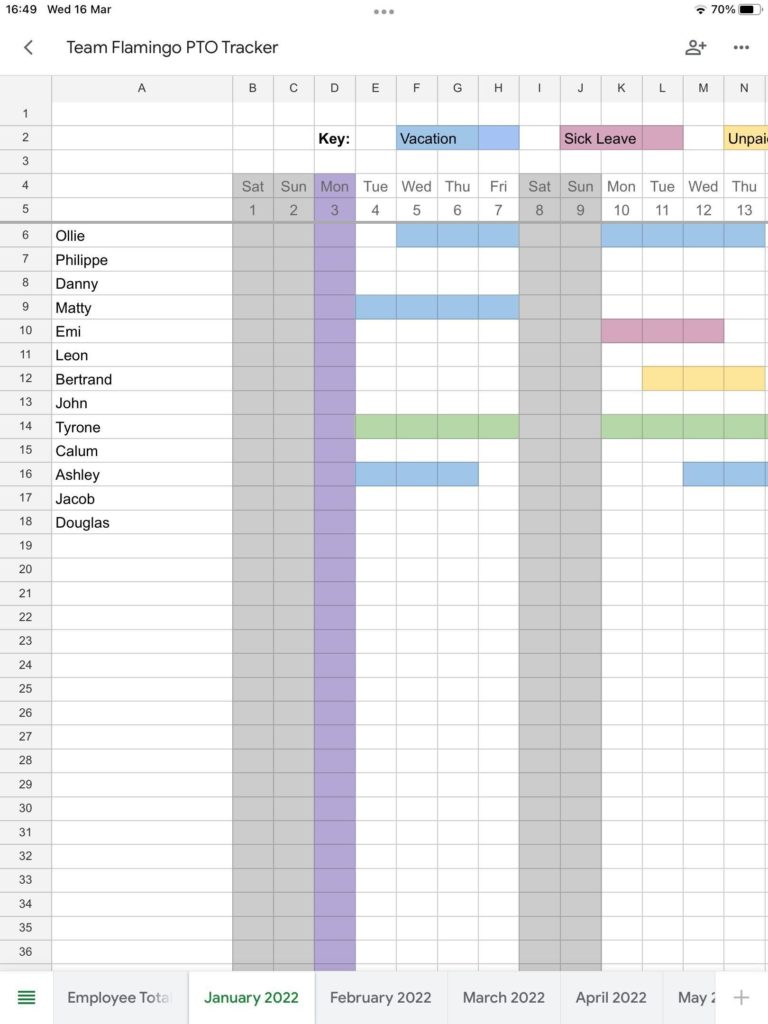
Since you’ve manually set up your paid time off tracker, it’s pretty easy to customize and make changes when needed.
Changing your team to a 4-day work week? Easy.
New staff, or existing staff leaving? No problem.
Changes made to your leave policy? Done.
You don’t need to worry about inflexible software that won’t let you make changes.
It’s also easy with permissions to share the spreadsheet with the right people and restrict it so only certain people can make changes to the sheet.
A vacation and sick time tracking spreadsheet requires a lot of data entry. For every approved leave request, you might need to fill out several fields to keep your spreadsheet up to date. It might not seem like much when the company consists of just a few people, but as you grow, this becomes a big drain on your productive hours.
Humans make errors. As much as we try not to, human error is unavoidable. It’s a matter of time until you forget to enter one leave into the spreadsheet. Then the day of the leave arrives, you’re looking for the person, and they’re not there.
Queue confusion, emotional outbursts from both sides, mistrust, and potential disruptions to workflow and deadlines.
A spreadsheet PTO tracker like this can work quite effectively, but it does take a lot of work to set up. Even just a simple version, with individual tabs for each month, takes some time to manually fill out with all your employees’ names, as well as dates and days of the week.
Setting up a way to keep track of total/remaining leave days for each leave type is another task on top of that. As a result, most founders or managers simply never get around to dedicating the time needed to build the perfect PTO tracker spreadsheet.
You can set up scripts in Google Sheets and Excel to automate certain parts of your time off tracking workflow, such as automatically updating an employee’s records each time they take a day off. But it takes a little know-how to set up these scripts, and even then they are a bit clunky.
It can also be awkward to pull reports on an employee, to see their absence patterns or leave records, unless your spreadsheet is very meticulously set up to manage this.
Flamingo’s automated PTO tracker is an alternative for teams who have outgrown manual leave management systems like spreadsheets.
While tracking PTO with a spreadsheet is flexible (and free), it takes a lot of time and headspace to maintain once your team starts growing past a few people.
Flamingo automates this, keeping your PTO calendar up to date without any effort or data entry.
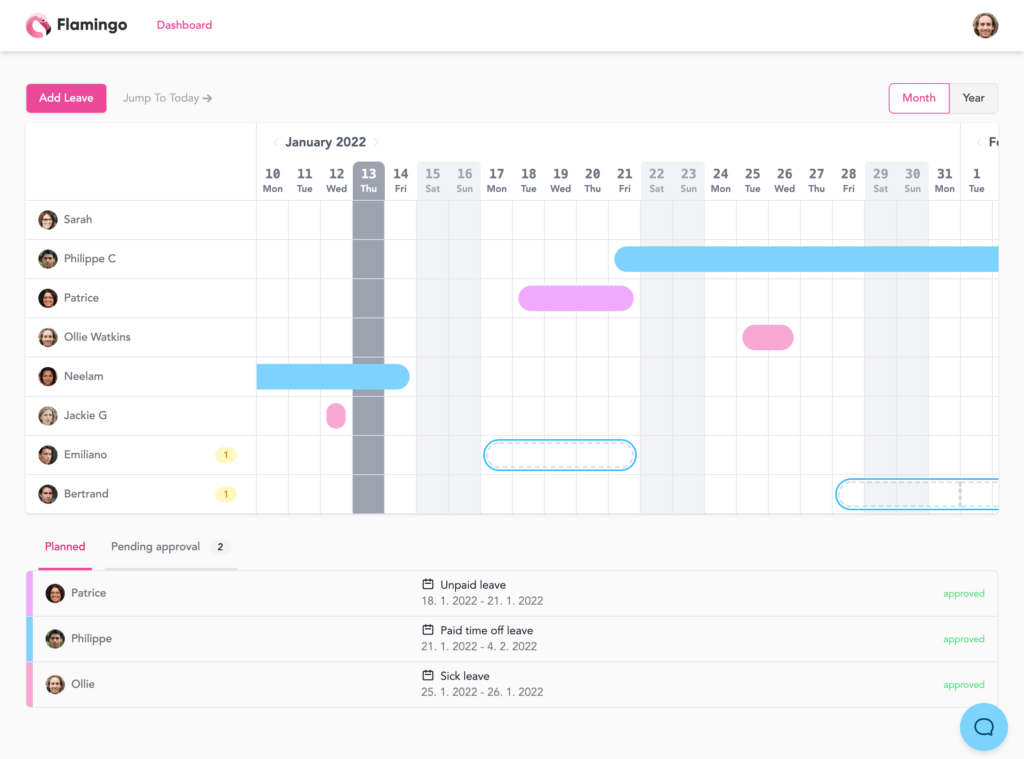
Flamingo also handles the leave request and approval process, creating a seamless process for asking for time off – and for managers or team leaders to review and approve or deny requests.
It keeps a record of each leave request, and allows you to pull a report on any employee’s leave records at any time.
Best of all, it’s not another huge cost to add to your business, or a huge pain to learn and get set up. Flamingo is free to try, and only rises in price as your business grows with it. That means as long as your team is small, the cost stay small as well.
It takes just a few minutes – even less if your team is still small and starting out – to set up. You can set it up while you make your morning coffee.
Flamingo integrates with Slack, so you don’t have to make wholesale changes to your existing workflow. And if you’re not using Slack, you can still use Flamingo’s standalone web app.
Flamingo streamlines leave management, letting you spend less time managing paid time off and more time growing your business
Here are a few big benefits of using an app like Flamingo instead of using a spreadsheet to track your team’s PTO, such as annual and sick leave.
Data entry, like filling in your spreadsheet every time someone applies for time off, doesn’t seem like a big job. But it adds up, and all that time is time that could be better spent on tasks that actually grow your bottom line. A software tool automates all this work, saving you time, as well as cutting out the little errors that grow into large disruptions.
When you click the button to add a leave management software to your organization, you’re getting a system that’s already set up and ready to go. No need to put aside a day to set up your spreadsheet, complete with each month and public holidays filled out for the whole year. It’s plug-and-play, which means you can get your leave management system up and working for you much faster.
A tool like Flamingo also has a system to manage leave requests and approvals. If you use a spreadsheet, you’re still reliant on email threads, private messages, face-to-face chats or even paper forms for leave requests.
This provides a huge amount of friction, high potential for error, and difficulty keeping or accessing records.
The right leave management software encompasses this step as well, making it simple to request time off to to review a time off request, and automatically transfers this data into your leave calendar.
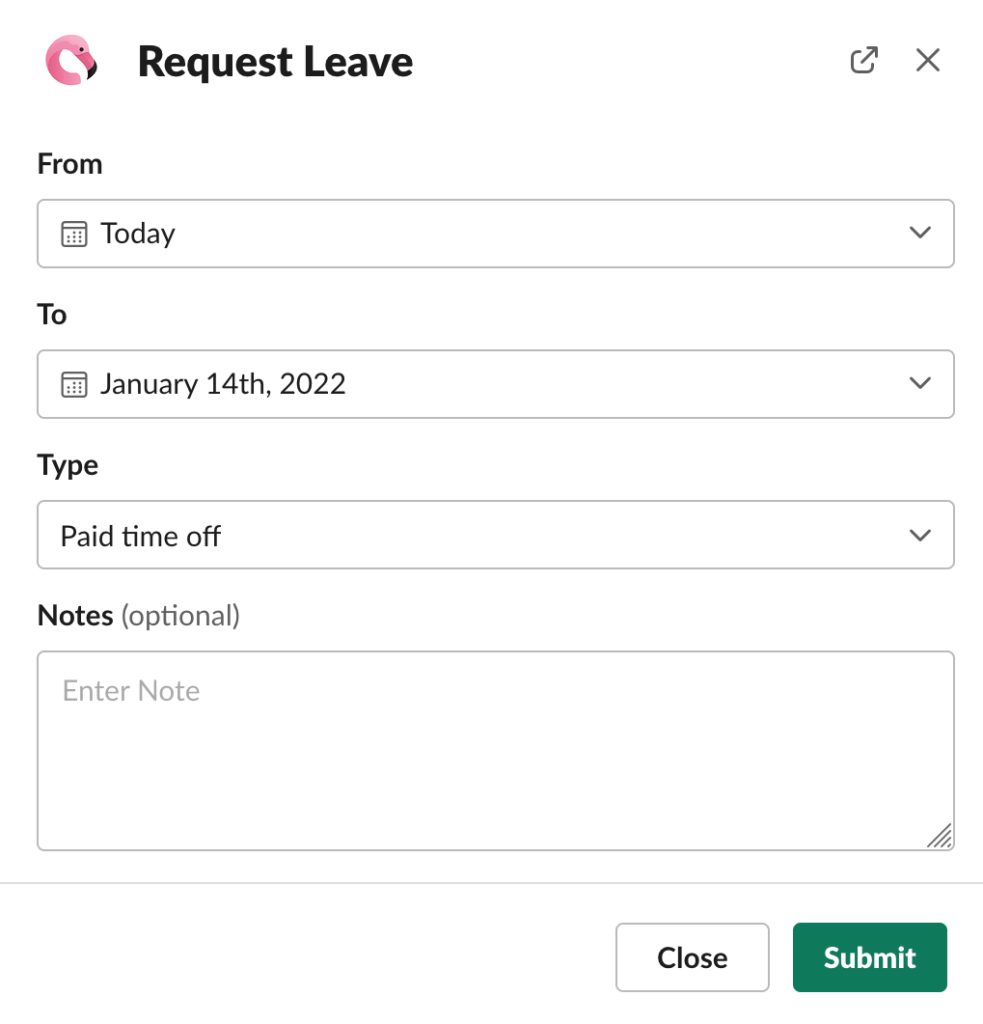
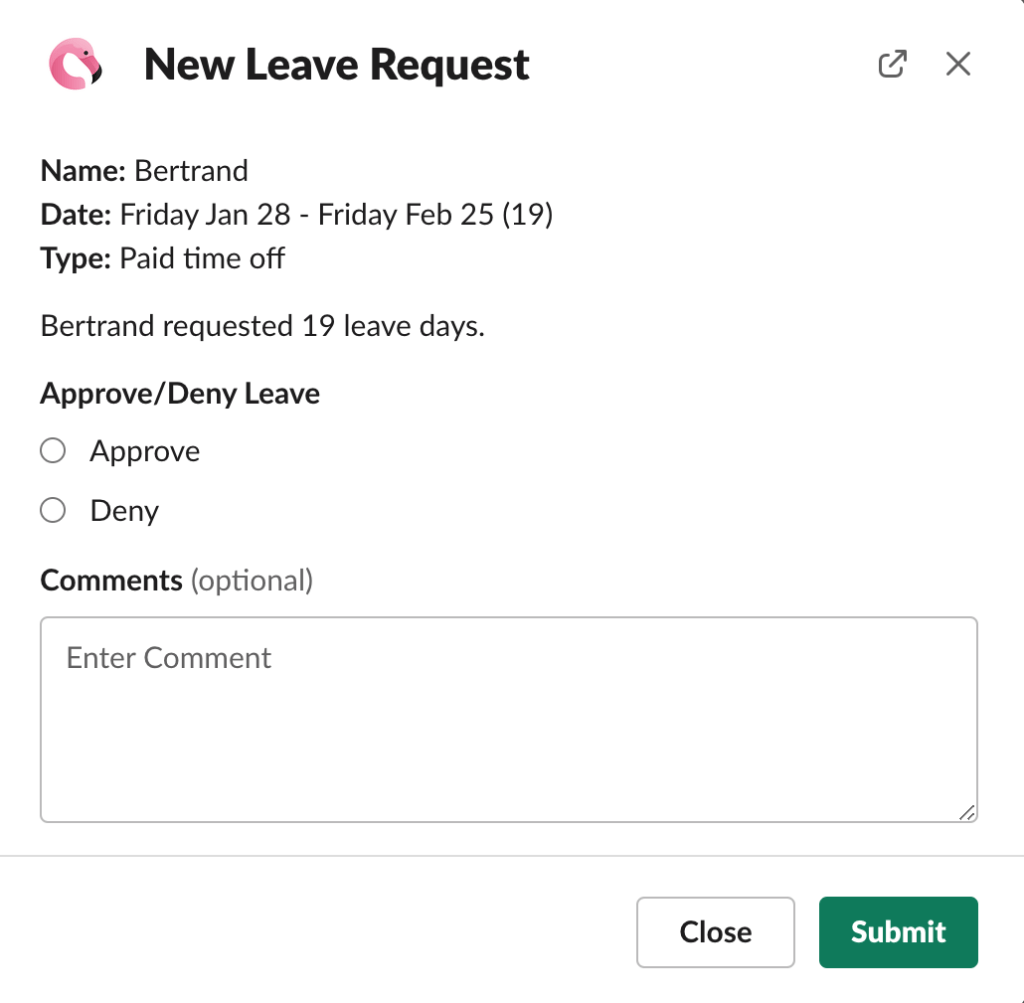
With a software tool you can often export your leave calendar – either your personal calendar, or the whole team’s calendar if you’re a manager or business owner – to an external calendar app like Google Calendar.
For a lot of people, this is a huge plus, as some of us literally run our lives on our calendar. Having this info sent to Google Calendar (or any other calendar app) helps keep your workflow all in one place.
A PTO tracker software can send notifications to a person or a team when there are leaves coming up, allowing everyone to stay up-to-date with the team schedule. This is another hugely complex thing to try and set up if you’re running on Google Sheets alone – and just about impossible to do reliably.
Your PTO software will also let you pull any information you need relating to your leave management system, at any given time, with just a single click, instead of trawling through your spreadsheet to piece together the data you need. This lets you identify trends and check up on the wellness of your team, quick and easily.
Trending: The Best Slack Apps for 2023
When you’re first starting your business and need a PTO tracker, Google Sheets is a decent option. It allows you to create a custom spreadsheet to fit your needs, and doesn’t require an expensive subscription or learning any complex features.
But as you grow, you’ll need a faster, more reliable solution, like a software tool. And you should probably begin to migrate your PTO tracker to a software tool before you get big enough to really need it, as this will avoid any growing pains when it comes time to move your team to a new system.
A software tool like Flamingo is perfect, whether you’re a large organization or a small team just starting out. It offers pricing that only grows as your team does, meaning it stays affordable, simple and easy to manage when your business is still in its early stages.
If you do want to try out a spreadsheet for your annual leave planner, you can use our employee holiday tracker template to get up and running fast.
But count up the time and errors saved by using Flamingo, and it’s a no-brainer to go with this option over Google Sheets or excel templates.
Flamingo makes managing your team’s paid time off a breeze.